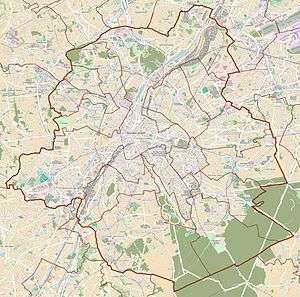De Brouckère Square
De Brouckère Square (French: Place De Brouckère, Dutch: De Brouckèreplein) is a major square located in central Brussels, Belgium. It is named in honour of Charles de Brouckère (1796–1860), a former mayor of the City of Brussels and professor at the Free University of Brussels, who played a great political role during the Belgian Revolution of 1830.
 De Brouckère Square in Brussels | |
 Location within Brussels | |
| Location | City of Brussels, Brussels-Capital Region, Belgium |
|---|---|
| Quarter | Marais–Jacqmain Quarter |
| Coordinates | 50°51′05″N 04°21′09″E |
| Construction | |
| Completion | c. 1870 |
De Brouckère Square is located in the perspective of Boulevard Emile Jacqmain/Emile Jacqmainlaan and Boulevard Adolphe Max/Adolphe Maxlaan to the north, forming a "Y" crossroad, and Boulevard Anspach/Anspachlaan to the south. It is served by the metro station De Brouckère on 1 and 5 of the Brussels metro.
The area around the square is characterised by the presence of theatres, a large cinema, hotels and restaurants, as well as some of the most important entertainment venues and shopping streets in the city.
History
De Brouckère Square was laid out following the covering of the Senne (1867–1871), as part of the major urban works by architect Léon Suys under the tenure of then-mayor of the City of Brussels, Jules Anspach.[1] It took the place of the former Augustinian church.[2] This church, built at the beginning of the 17th century in the Baroque style, was the only remaining part of a convent destroyed in 1796 by French revolutionaries. The work to cover the river, which nearly surrounded the church, preserved the integrity of the building at great trouble and expense, but it was finally demolished in 1893, its style no longer popular with the people and its presence unsuitable for the area. Its facade, however, was preserved, being disassembled and moved to serve for the Church of the Holy Trinity in the municipality of Ixelles.[3]
.jpg)
In the centre of the square, left empty by the destruction of the church, a fountain-obelisk dedicated to the memory of Jules Anspach was erected. Inaugurated in 1897, the Anspach Fountain was removed in 1973 to make room for access to the metro station. The authorities had promised to put it back in place after the works, but it was eventually reinstalled in May 1981 in a basin that occupies the space between the Quai aux Briques/Baksteenkaai and the Quai au Bois à Brûler/Brandhoutkaai in the Sainte-Catherine/Sint Katelijne neighbourhood.[4]
Since 29 June 2015, the square has been partially pedestrianised, as part of a large pedestrian zone in the centre of Brussels.[5]
Places of interest
De Brouckère Square is dominated by fin de siècle buildings, but modern colossi (Philips Tower and Monnaie Center) have also risen on its southern side since the 1960s. The focal point is the Hotel Continental (1874) by the architect Eugène Carpentier, well known to people of Brussels because of the large luminous Coca-Cola sign on its roof.[6] This roof was considerably simplified following the fire that ravaged the building in 1901.[7]
The square is home to the Hotel Metropole (1895), where the first Solvay Conference on Physics and on Chemistry was held in the autumn of 1911.[8][9] On the opposite side stands the former Eldorado cinema, now the UGC De Brouckère, with its Grand Room featuring African-themed Art Deco motifs by the architect Marcel Chabot.[10] On the south-eastern side of the square are two covered shopping galleries: the Anspach Center and the Mint Center.
 Hotel Metropole, Trappeniers (1872)
Hotel Metropole, Trappeniers (1872)- Hotel Continental, Carpentier (1874)
 Philips Tower (1969)
Philips Tower (1969)
Bibliography
- Demey, Thierry (1990). Bruxelles, chronique d’une capitale en chantier (in French). I: Du voûtement de la Senne à la jonction Nord-Midi. Brussels: Paul Legrain/CFC. OCLC 44643865.CS1 maint: ref=harv (link)
- Centre d'information, de Documentation et d'Etude du Patrimoine (1997). Bruxelles, ville d'Art et d'Histoire: Les Boulevards du Centre (in French). Brussels: Ministère de la Région de Bruxelles-Capitale, Service des Monuments et des Sites.
See also
References
- Demey 1990, p. 65.
- Centre d'information, de Documentation et d'Etude du Patrimoine, Bruxelles, ville d'Art et d'Histoire: Les Boulevards du Centre (1997), p. 30.
- "Ixelles - Église paroissiale de la Sainte-Trinité - Parvis de la Trinité - VAN YSENDIJCK Jules Jacques". www.irismonument.be (in French). Retrieved 2018-05-19.
- "Les fontaines dans la région de Bruxelles-Capitale". eurobru.com. 2007. Archived from the original on October 7, 2007. Retrieved November 8, 2007.
- "Project. Pedestrian zone". www.brussels.be. 2017-02-28. Retrieved 2018-12-15.
- "Bruxelles Pentagone - Hôtel Continental - Place De Brouckère 41 - Boulevard Emile Jacqmain 1-1a-1b-3-5-7-9-11-13-15-19 - Boulevard Adolphe Max 6-10-12-22-26 - Rue Saint-Michel 1-5 - CARPENTIER E." www.irismonument.be. Retrieved 2019-07-28.
- Centre d'information, de Documentation et d'Etude du Patrimoine, Bruxelles, ville d'Art et d'Histoire: Les Boulevards du Centre (1997), p. 14.
- "Bruxelles Pentagone - Hôtel Métropole - Place De Brouckère 31 - TRAPPENIERS A." www.irismonument.be. Retrieved 2019-07-28.
- "Brussels City Centre Hotels | Hotel Metropole Brussels - About | Art Nouveau Hotel Brussels". www.metropolehotel.com. Retrieved 2018-05-18.
- "Bruxelles Pentagone - Ancien cinéma Eldorado - Place De Brouckère 34-38, 40-42-44-46". www.irismonument.be. Retrieved 2019-07-28.